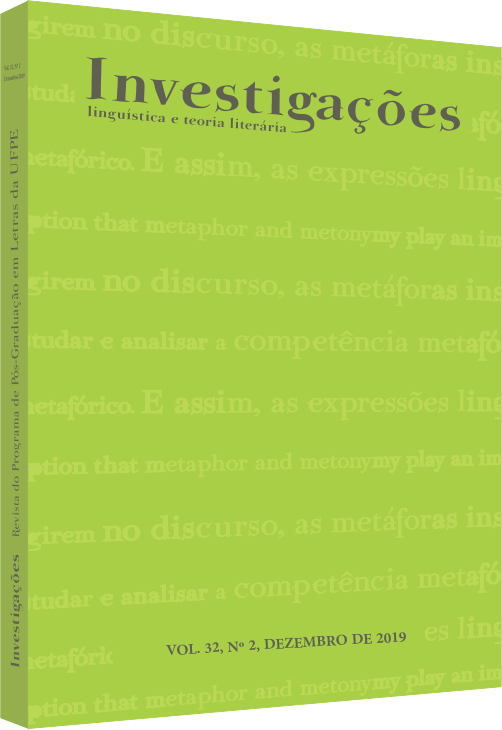Articulação oracional e produção escrita: um trabalho com o pronome relativo
DOI:
https://doi.org/10.51359/2175-294x.2019.241458Keywords:
relative pronoun, clause combining, written texts, functional linguistics.Abstract
We describeand an analyzea class activity developed with 9thgrade students of an elementary schoolfocusing on the use of the relative pronoun in a situation of formalwriting. The aimwas to improve the use of this linguistic item by the studentsin order for them to articulate pieces of texts. Adidactic sequence was developed through an interventional qualitative research. The theoretical and methodologicalsupport isthe North AmericanFunctional Linguistics. As results, we highlight the students' progress regarding the adequate use of the relative pronoun in a formal context of language usage.References
ANTUNES, I. Lutar com palavras: coesão e coerência. São Paulo: Parábola Editorial, 2005.
BAGNO, M. Gramática pedagógica do português brasileiro. São Paulo: Parábola, 2011.
BECHARA, E. Moderna gramática portuguesa. 37. ed. rev., ampl. e atual. conforme o novo Acordo Ortográfico. Rio de Janeiro: Nova Fronteira, 2009.
BISPO, E. B. Estratégias de relativização no PB: motivações discursivo-interacionais e cognitivas. In: BISPO, E. B.; OLIVEIRA, M. R. de (Orgs.). Orações relativas no português brasileiro: diferentes perspectivas. Niterói: Editora da UFF, 2014, p.131-155.
BISPO, E. B. Oração adjetiva cortadora: análise de ocorrências e implicações para o ensino de português. Linguagem & Ensino, v. 10, p. 163-186, 2007.
BRASIL, Secretaria de Educação Fundamental. Parâmetros Curriculares Nacionais: terceiro e quarto ciclos do ensino fundamental – língua portuguesa. Brasília/DF: MEC/SEF, 1998.
CASTILHO, A. T. de. Nova Gramática do Português Brasileiro. São Paulo: Contexto, 2010.
DOLZ, J.; NOVERRAZ, M.; SCHNEUWLY, B. Sequências didáticas para o oral e a escrita: apresentação de um procedimento. In: DOLZ, J.; SCHNEUWLY, B. Gêneros orais e escritos na escola. [Tradução e organização: Roxane Rojo e Glaís Sales Cordeiro]. Campinas, SP: Mercado das Letras, 2004, p. 96-128.
DU BOIS, J. W. Competing motivations. In: HAIMAN, J. (ed.). Iconicity in syntax. Amsterdam: John Benjamins, 1985, p. 343-365.
FURTADO DA CUNHA, M. A.; BISPO, E. B; SILVA. J. R. Linguística funcional centrada no uso e ensino de português. Gragoatá, n. 36, p. 80-104, 2014.
GIVÓN, T. Functionalism and grammar. Amsterdan: John Benjamins, 1995.
GIVÓN, T. Syntax: a functional-typological introduction. v. II, Amsterdam: John Benjamins, 1990.
GIVÓN, T. Syntax: a functional-typological introduction. v. I, Amsterdam: John Benjamins, 1984.
KENEDY, E. Estruturas sintáticas de orações relativas. In: BISPO, E. B.; OLIVEIRA, M. R. de (Orgs.). Orações relativas no português brasileiro: diferentes perspectivas. Niterói: Editora da UFF, 2014, p. 11-46.
MARTELOTTA. M. E. Mudança linguística: uma abordagem baseada no uso. São Paulo: Cortez, 2011.
OLIVEIRA. M. R. de; WILSON, V. Linguística funcional aplicada ao ensino do português. In: FURTADO DA CUNHA, M. A.; OLIVEIRA, M. R. de; MATELOTTA, M. E. (Orgs.). Linguística funcional: teoria e prática. São Paulo: Parábola Editorial, 2015, p. 79-110.
SLOBIN, D. I. Psicolinguística. São Paulo: Editora Nacional/EDUSP, 1980.
TRAVAGLIA, L. C. Gramática e interação: uma proposta para o ensino de gramática no 1º e 2º graus. 8 ed. São Paulo: Cortez, 2002.
Downloads
Published
How to Cite
Issue
Section
License
Copyright (c) 2019 Edvaldo Balduino Bispo, Maria Estela Lima da Costa Amurim

This work is licensed under a Creative Commons Attribution 4.0 International License.
Authors who publish with Revista Investigações agree to the following terms:
Authors retain copyright and grant the journal right of first publication with the work simultaneously licensed under the Creative Commons Attribution 4.0 International (CC BY 4.0) license that allows others to share the work with an acknowledgement of the work's authorship and initial publication in this journal.
Authors are able to enter into separate, additional contractual arrangements for the non-exclusive distribution of the journal's published version of the work (e.g., post it to an institutional repository or publish it in a book), with an acknowledgement of its initial publication in this journal.
You are free to:
Share — copy and redistribute the material in any medium or format for any purpose, even commercially.
Adapt — remix, transform, and build upon the material for any purpose, even commercially.
The licensor cannot revoke these freedoms as long as you follow the license terms.
Under the following terms:
Attribution — You must give appropriate credit , provide a link to the license, and indicate if changes were made . You may do so in any reasonable manner, but not in any way that suggests the licensor endorses you or your use.
No additional restrictions — You may not apply legal terms or technological measures that legally restrict others from doing anything the license permits.

